3.03.2021
Delta IV Heavy Rocket Takes Trek to Launch Pad at Vandenberg AFB Ahead of Spring Liftoff
Behemoth booster set to carry top-secret payload for National Reconnaissance Office
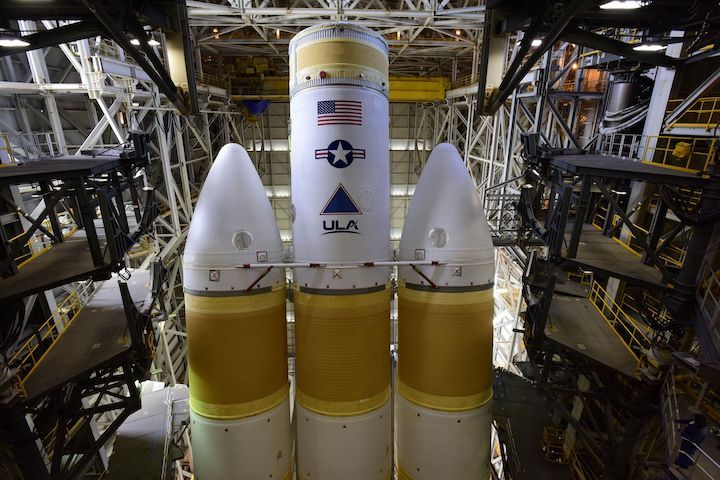
Standing upright at Space Launch Complex-6 at Vandenberg Air Force Base, the Delta IV Heavy rocket awaits the arrival of its cargo, a top secret payload for the National Reconnaissance Office, and nose cone ahead of the planned launch this spring. (Contributed photo)
A short trip for a Delta IV Heavy rocket served as the prelude for a much longer trek this spring at Vandenberg Air Force Base.
Stretched out on its transporter trailer equipped with 36 wheels, the United Launch Alliance booster recently traveled from the Horizontal Integration Facility to its stand at Space Launch Complex-6 on South Base.
Upon arrival, the hulking rocket was raised into a standing position in anticipation of its blastoff later this spring.
The Delta IV Heavy employs three common booster cores side by side to give the rocket more power for carrying monstrous-sized payloads into space.
The trip to the launch pad was one of many key milestones before the rocket’s countdown to zero and its longer trip to place a top-secret payload in space for theNational Reconnaissance Office for a mission dubbed NROL-82.
NRO representatives remain mum about their satellites’ role beyond calling them critical national security payloads.
The Delta IV Heavy's components have spent the past 10 months readying for the trek to the launch pad.
Following a sea-faring voyage from its Decatur, Alabama, manufacturing plant to the Central Coast, the Delta IV Heavy arrived at Vandenberg last spring, according to ULA.
Unloading the vessel dubbed R/S RocketShip took a bit longer than planned due to an uncooperative ocean.
Since then, the rocket components have undergone assorted tests to prepare for flight.
Still to come is installation of the cargo — typically the size of a bus — scheduled to ride inside the rocket’s nosecone, or payload fairing.


Once fully assembled, the Delta IV Heavy rocket will stand some 23-stories tall.
After the payload completes processing, the spacecraft will be placed atop the rocket and the nosecone will be snapped into place.
That step won’t occur until after the launch team completes “a wet dress rehearsal,” which involves conducting a practice that includes loading fuel and achieving other pre-launch milestones, but remaining in place once the countdown reaches zero.
This will be ULA’s 13th Delta IV Heavy and the fourth from Vandenberg.
The West Coast’s previous Delta IV Heavy rocket blasted off in January 2019, also to carry an NRO payload into space.
After a light year in 2020 due to few satellites needing rides to space aboard rockets launched from Vandenberg, the pace will pick up in 2021. This spring also may bring the debut of a booster built by a fledgling firm, Firefly Aerospace.
Vandenberg recently kicked off its 2021 launch year with the first test of an unarmed Minuteman III intercontinental ballistic missile.
Quelle: Noozhawk
----
Update: 14.04.2021
.
Delta IV Heavy Team Readies Rocket for Blastoff from Vandenberg AFB
Mission carrying top-secret payload is aiming for April 26 liftoff from South Base launch pad
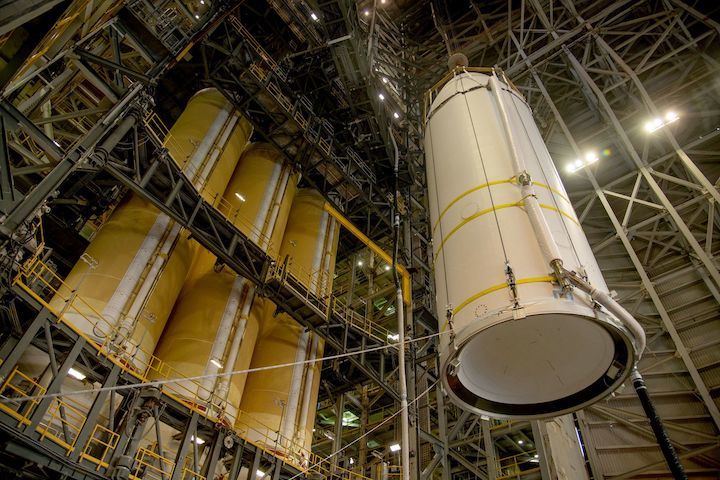
A National Reconnaissance Office payload dubbed NROL-82 is mounted on top of the United Launch Alliance (ULA) Delta IV Heavy rocket ahead of lliftoff later this month at Vandenberg Air Force Base. (United Launch Alliance photo)
A Delta IV Heavy rocket and its top-secret cargo at Vandenberg Air Force Base now have been united ahead of their targeted departure date.
United Launch Alliance recently announced that the 233-foot-tall rocket will aim for an afternoon blastoff on April 26.
The Delta IV Heavy already sits at Space Launch Complex-6, once planned to be the home of the West Coast space shuttle program, on South Base.
Crews recently placed the payload, only identified as key for national security, atop the booster as one more vital step to ready for launch.
Since the rocket will carry spacecraft for the National Reconnaissance Office, the targeted launch time and actual launch window for the rocket have not been released for the mission dubbed NROL-82.
However, on Monday NRO officials said the launch opportunity would stretch from 12:39 p.m. to 3:57 p.m. The planned launch time will be released closer to the liftoff date.
While some launch sites can be seen from off-base viewing sites, SLC-6 sits in a valley as one of the most southern launch facilities at Vandenberg.
Spectators must await the rocket’s rise above the hills to see the flight — as long as Mother Nature keeps the marine layer away.


Before mating the payload to the rocket, the Delta IV Heavy team recently conducted a “wet dress rehearsal” in which they performed a mock countdown, including key pre-launch milestones such as fueling the rocket, which remained on the pad after reaching zero.
The practice session allowed the team to test various systems to spot any potential issues that could cause delays on launch day.
For the exercise, the rocket’s cargo and its 63-foot-long nosecone or payload fairing had not been attached yet as a precaution.
This will be ULA’s 13th Delta IV Heavy launch and the fourth from Vandenberg.
The West Coast’s previous Delta IV Heavy rocket blasted off in January 2019, also to carry an NRO payload into space.
ULA will provide a countdown status blog and live webcast, links available here, on launch day.
Quelle: Noozhawk
----
Update: 15.04.2021
.
WORLD'S MOST POWERFUL HYDROGEN-FUELED ROCKET ENGINE COMPLETES FINAL ACCEPTANCE TEST FOR ULA DELTA IV HEAVY LAUNCH VEHICLE
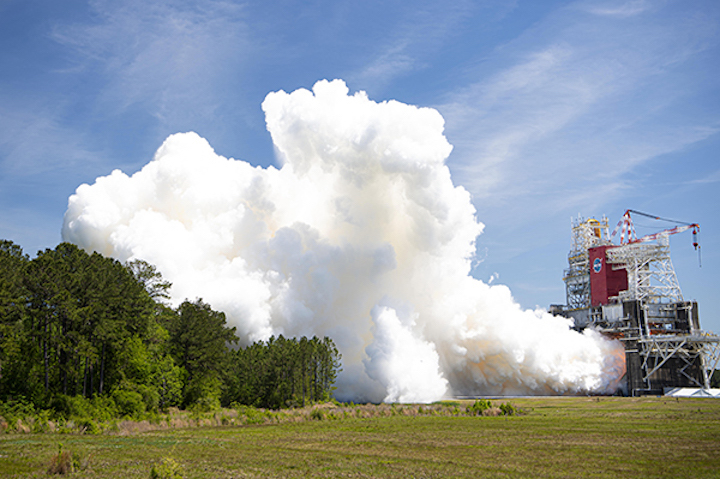
Today, the world’s most powerful hydrogen-fueled rocket engine built by Aerojet Rocketdyne, the RS-68A, completed its final hot-fire acceptance test for use on the United Launch Alliance (ULA) Delta IV Heavy launch vehicle on the B-1 Test Stand at NASA’s Stennis Space Center in Mississippi.
ULA’s Delta IV Heavy rocket uses three Aerojet Rocketdyne RS-68A engines; one on each of its three common booster cores to launch the nation’s most critical spacecraft into orbit. The three RS-68A engines combine to generate more than two million pounds of thrust for the Delta IV Heavy.
“The throttleable RS-68A engine has been the centerpiece of the Delta IV Heavy rocket for more than 15 years,” said Eileen P. Drake, Aerojet Rocketdyne CEO and president. “We are very proud of the 65 engines flown to date and their flawless performance record.”
Conceived using a simplified design approach to lower cost while maintaining its overall reliability, the original variant of the engine, the RS-68, was first tested at Edwards Air Force Base in California; testing later moved to Stennis in 2000. The RS-68 powered Delta IV made its inaugural flight in 2002.
“We’ve continued to improve the RS-68 engine, which today remains the most powerful hydrogen-fueled rocket engine in the world,” said Jim Maser, Aerojet Rocketdyne senior vice president of Space. “This engine was developed entirely with company funds to be a very cost competitive and extremely reliable booster engine.”
The upgraded RS-68A, which generates 705,000 pounds of thrust at sea level, completed its first test firing in September 2008, was certified in April 2011 and made its inaugural flight in June 2012.
“Our RS-68 test partnership with Aerojet Rocketdyne spans more than 20 years and the final RS-68 hot-fire test closes out a historic chapter in propulsion testing at Stennis Space Center,” said NASA’s Stennis Space Center Director Richard Gilbrech. “The RS-68 was the first engine to be both assembled and tested at Stennis. While this particular test project is ending, we look forward to continued work with Aerojet Rocketdyne on future endeavors.”
In addition to launching numerous payloads supporting the U.S. Air Force Space Command and the National Reconnaissance Office, the Delta IV Heavy carried NASA’s Orion spacecraft on the EFT-1 mission in December 2014, and launched the Parker Solar Probe on its mission to unlock the mysteries of the Sun in August 2018. The Delta IV Heavy, powered by the RS-68A engine, continues to be the primary heavy-lift launch vehicle for the United States.
The Delta IV Heavy has four launches remaining.
Aerojet Rocketdyne’s work at NASA’s Stennis Space Center continues with final assembly and test of the RS-25 engine that powers the core stage of America’s next super heavy-lift rocket, the Space Launch System (SLS). The most powerful rocket ever built, SLS will send humans to explore the Moon as part of the NASA’s Artemis program.
Quelle: Aerojet Rocketdyne
----
Update: 26.04.2021
.
One of ULA’s four remaining Delta 4 rockets set to launch from California
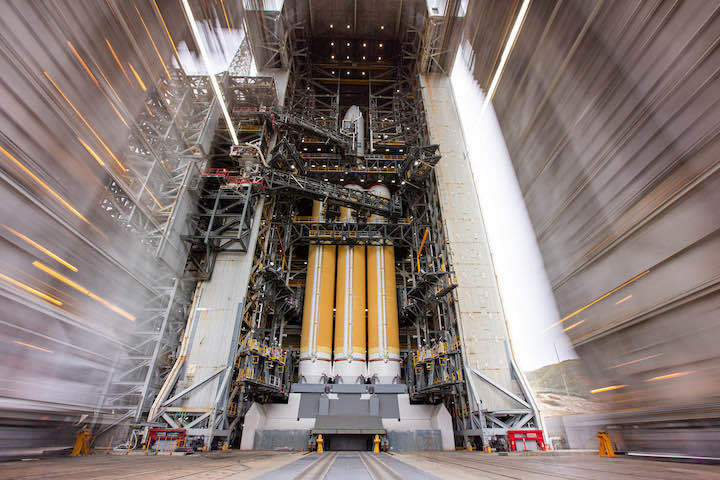
United Launch Alliance ground crews on California’s Central Coast are gearing up to send a classified U.S. government spy satellite into orbit as soon as Monday — weather permitting — aboard one of the company’s four remaining Delta 4-Heavy rockets.
Liftoff of the powerhouse hydrogen-fueled launcher is set for 1:46 p.m. PDT (4:46 p.m. EDT; 2046 GMT) from Vandenberg Air Force Base, California. There is a 40% chance of favorable weather for Monday’s launch opportunity, according to the official launch forecast issued by the U.S. Space Force.
The weather concerns Monday include surface winds, cumulus clouds, thick clouds, and precipitation. The exact duration of the launch window Monday has not been disclosed. The NRO said earlier this month the mission’s launch period extended from 12:39-3:57 p.m. PDT (3:39-6:57 p.m. EDT; 1939-2257 GMT).
If the launch is scrubbed Monday, there is also a 40% chance of acceptable conditions for liftoff Tuesday.
ULA, a 50-50 joint venture between Boeing and Lockheed Martin, has four Delta 4-Heavy rockets left to launch in the next few years. All are assigned to haul top secret satellites into space for the National Reconnaissance Office, which owns the U.S. government’s fleet of orbiting spy platforms.
The rest of the Delta rocket family, including the single-core Delta 4-Medium, has been retired as ULA transitions to the next-generation Vulcan Centaur rocket. The Delta 4-Heavy, created by joining there Delta 4 common booster cores together, is tailored for carrying the U.S. government’s largest intelligence-gathering spacecraft into orbit.
The next Delta 4-Heavy launch, designated NROL-82, will blast off from Space Launch Complex-6 at Vandenberg, a picturesque location overlooking the Pacific Ocean. It will be the 42nd flight of a Delta 4 rocket since 2002, and the 13th launch of the Delta 4-Heavy configuration.
The NROL-82 mission will be ULA’s first launch of 2021. If the rest of ULA’s launch schedule remains on track, the company could conduct as many as 10 missions before the end of December, but the majority of the flights aren’t expected to take off until the second half of the year.
While government officials have not disclosed any information about the payload riding on the NROL-82 mission, independent analysts believe the Delta 4-Heavy rocket will likely deliver the NRO’s next KH-11 optical reconnaissance satellite to orbit. The KH-11 satellites are about the size of a bus, fitted with large telescopes pointing down at Earth to collect unmatched high-resolution images of strategic locations around the world for analysis by U.S. intelligence agencies.

Often called “Keyhole” satellites, he KH-11 spacecraft require the heavy-lifting capability of the Delta 4-Heavy, along with the rocket’s voluminous payload shroud. All of the Delta 4-Heavy missions from Vandenberg have carried KH-11 satellites to space. The exact imaging capabilities of the KH-11 satellites are top secret, and the NRO does not publicly identify the types of spacecraft on each of its launches.
Information about the Delta 4-Heavy rocket’s post-launch trajectory released by ULA and published in open navigational warnings indicate the launcher will head slightly west of due south from Vandenberg, according to Marco Langbroek, a Dutch archaeologist and an expert in the orbits of military satellites.
The ground track suggests the Delta 4-Heavy will place its cargo into a sun-synchronous polar orbit with an inclination of about 98 degrees to the equator, Langbroek wrote on his website.
The timing of the launch Monday closely aligns with the orbital plane of a KH-11 satellite launched in January 2011 aboard a previous Delta 4-Heavy mission. The new satellite might be a replacement for that 10-year-old spacecraft.
The NRO has at least three active KH-11 satellites launched in 2005, 2011, and 2013, all flying in the same type of sun-synchronous orbit. The most recent Delta 4-Heavy launch from Vandenberg in 2019deployed its NRO spy satellite cargo into a different orbit, raising questions whether it carried a KH-11 satellite or another kind of clandestine spacecraft.
Ted Molczan, an experienced satellite tracker in Canada, agreed with Langbroek’s assessment that the NROL-82 mission will haul a KH-11-type satellite into space.
In 2019, former President Donald Trump tweeted a declassified image widely believed to be from a KH-11 satellite, showing damage on an Iranian launch pad after a rocket explosion. Using sun angles, civilian sleuths estimated the time the picture was taken, then cross-checked the time with the known positions of NRO spy satellites.

ULA raised the Delta 4-Heavy rocket on the SLC-6 launch pad in February. Since then, the launch team completed a “wet dress rehearsal” in which they loaded the Delta 4-Heavy with cryogenic liquid hydrogen and liquid oxygen propellants.
Ground crews installed the NROL-82 mission’s secret payload on top of the Delta 4-Heavy earlier this month, the final element to complete stacking of the 233-foot-tall (71-meter) rocket.
The NROL-82 mission will be the ninth Delta 4 mission to depart from the SLC-6 launch pad, a facility once designed to host space shuttle launches on the West Coast. When NASA abandoned plans to fly space shuttles from California after the Challenger accident, the launch pad languished until Boeing became next long-term tenant to enable Delta 4 launches.
Boeing merged its Delta rocket program with Lockheed Martin’s Atlas 5 program in 2006 to create ULA.
Like all launches for the National Reconnaissance Office, the final phase of the Delta 4-Heavy mission Monday will occur out of public view. The NRO typically orders news blackouts and officials launch broadcasts conclude a few minutes after liftoff.
The Delta 4-Heavy rocket’s three Aerojet Rocketdyne RS-68A main engines will drive the launcher off the planet with 2.1 million pounds of thrust, equivalent to 51 million horsepower.
Heading south over the Pacific, the rocket will surpass the speed of sound at T+plus 1 minute, 23 seconds.
The core engine of the triple-body rocket will run at a partial thrust setting for the first few minutes of the flight to save propellant. The side boosters will consume their fuel and shut down their engines at T+plus 3 minutes, 56 seconds. The boosters will jettison two seconds later to fall into the Pacific Ocean.
The core RS-68A engine will throttle up to full power and burn until T+plus 5 minutes, 37 seconds. Stage separation is scheduled for T+plus 5 minutes, 44 seconds, followed by ignition of the second stage’s Aerojet Rocketdyne RL10 engine at T+plus 5 minutes, 56 seconds.
The Delta 4-Heavy’s payload fairing will jettison at T+plus 6 minutes, 7 seconds, and ULA’s launch broadcast will conclude moments later. ULA and the NRO are expected to confirm the outcome of the rest of the mission on social media and in press releases later Monday afternoon.
Assuming the Delta 4-Heavy is carrying a KH-11 spysat, the rocket’s upper stage is expected to target an elongated orbit ranging as high as 620 miles (1,000 kilometers) in altitude.
After Monday’s launch, ULA will have one more Delta 4-Heavy launch left in its backlog from Vandenberg. The other two Delta 4-Heavy missions left to launch will blast off from Cape Canaveral Space Force Station, Florida.
Quelle: SN
+++

ULA's Delta IV Heavy rocket lifts off from Vandenberg Air Force Base, CA with the NROL-82 mission for the National Reconnaissance Office (NRO). Launch is scheduled for 1:46 p.m. PDT (4:46 p.m. EDT.) on Mon., April 26, 2021. Broadcast is scheduled for 1:26 p.m. PDT (4:26 p.m. EDT.)

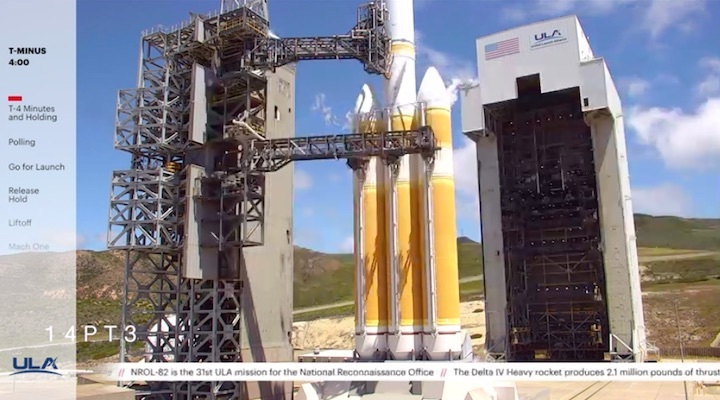
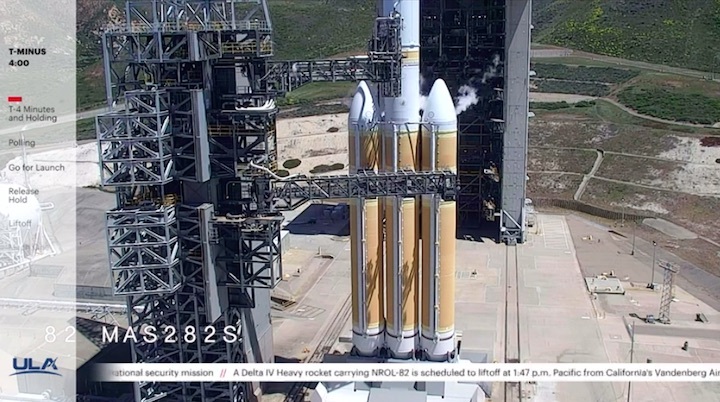
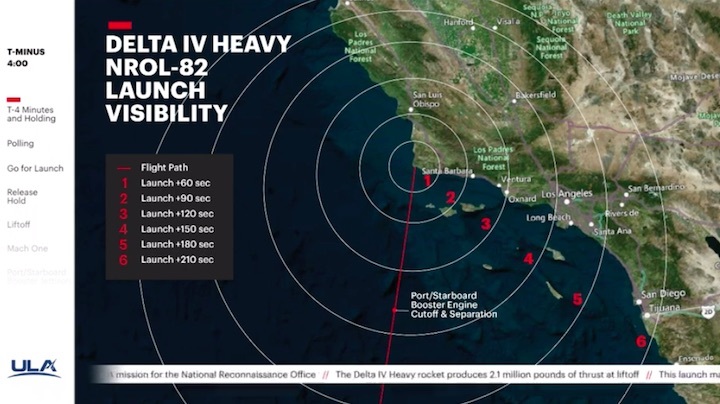
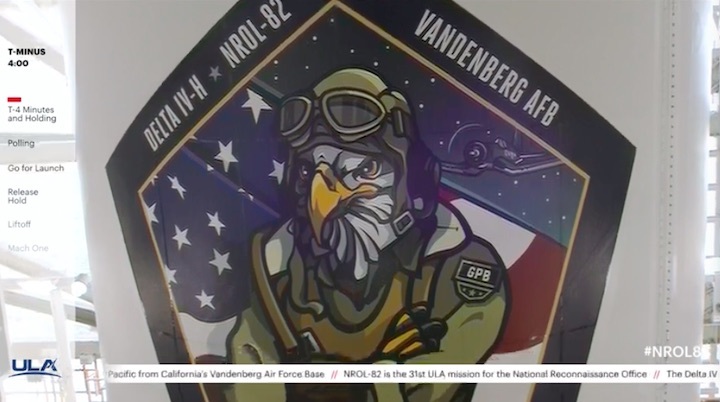
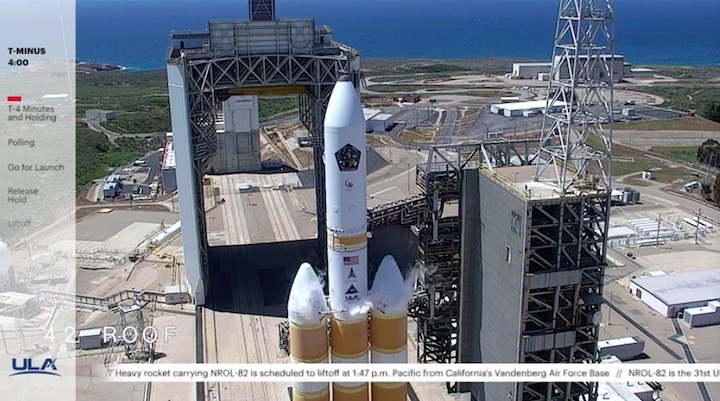
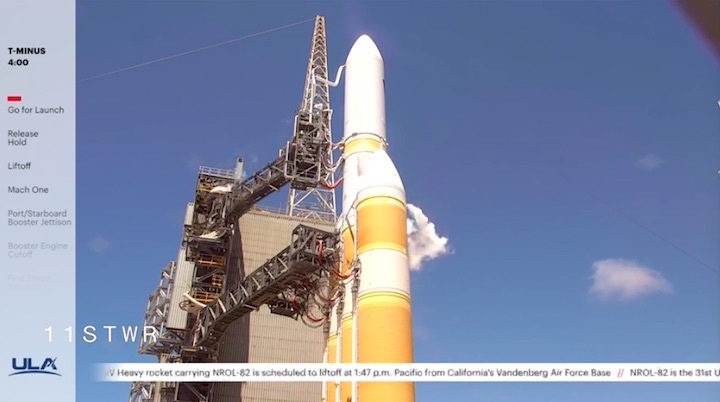
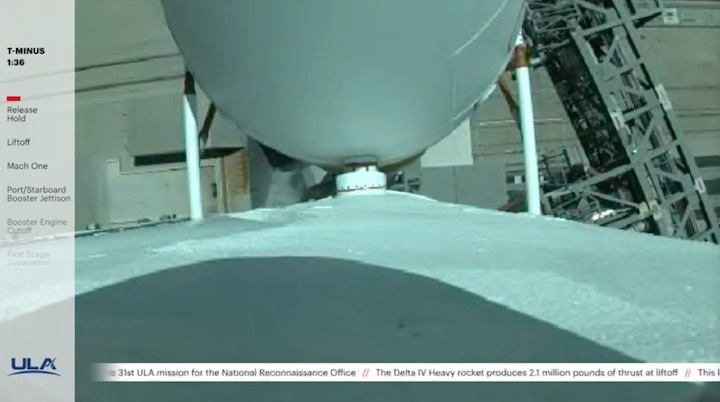



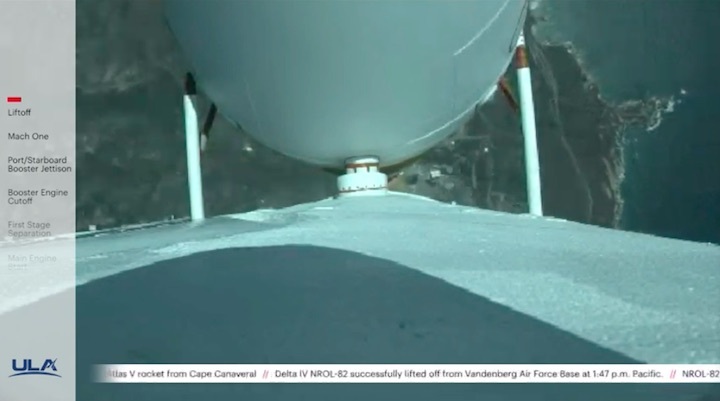

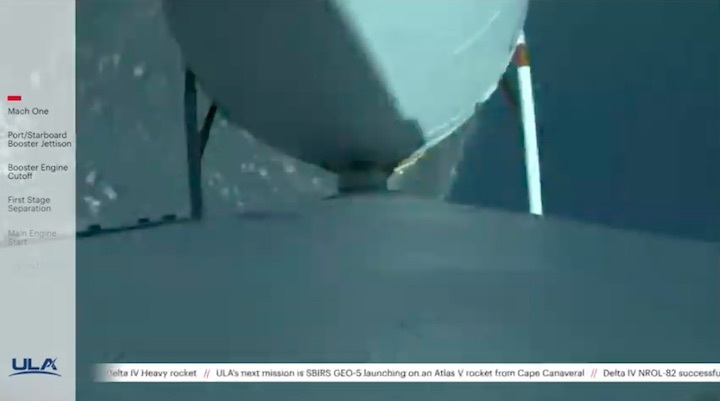
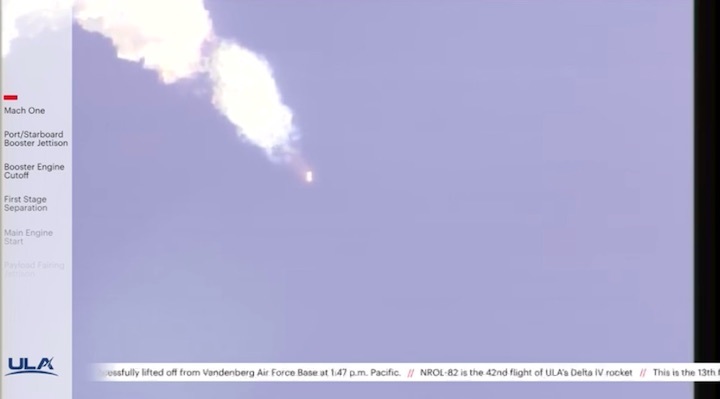
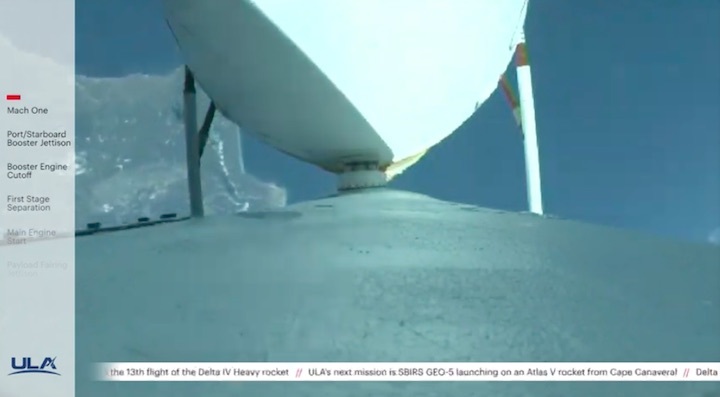

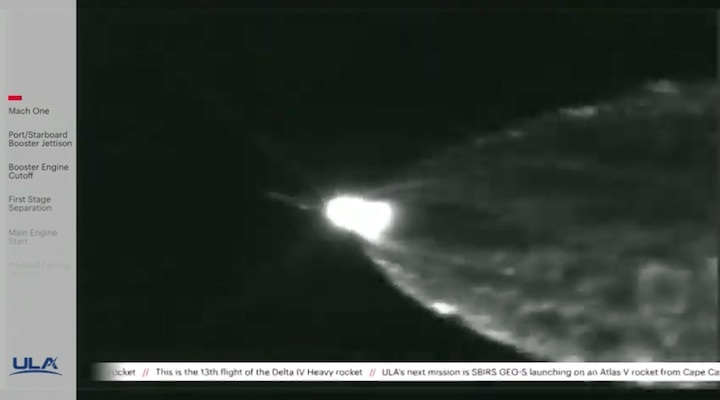
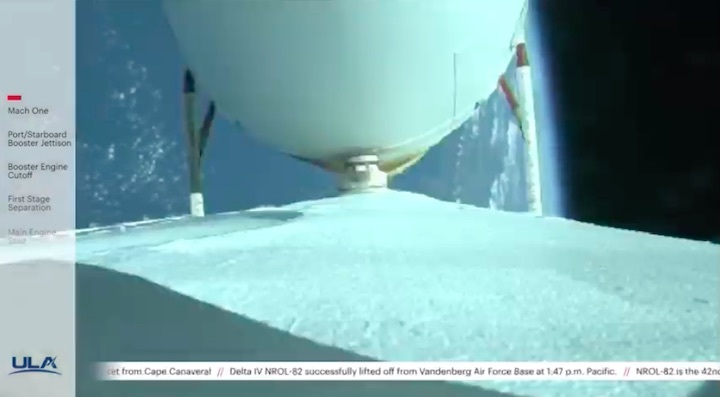
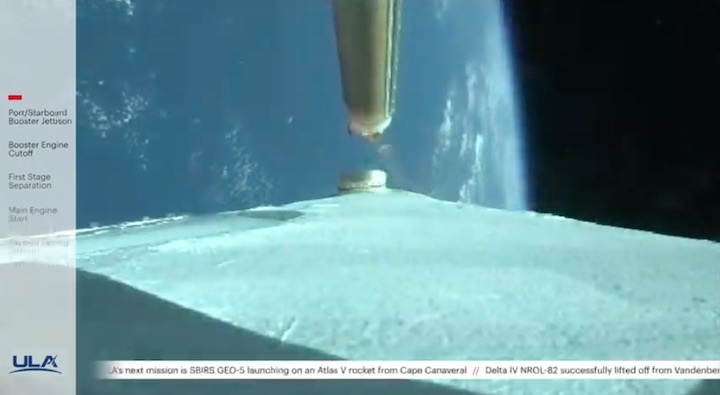
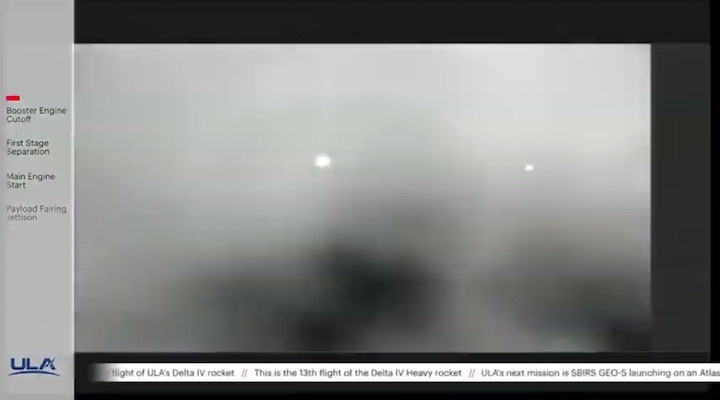
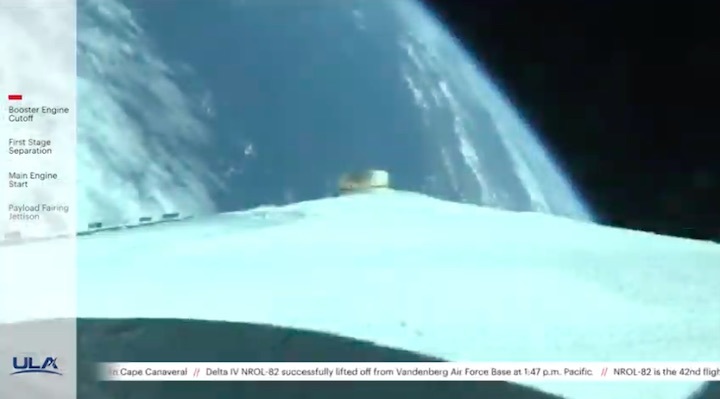
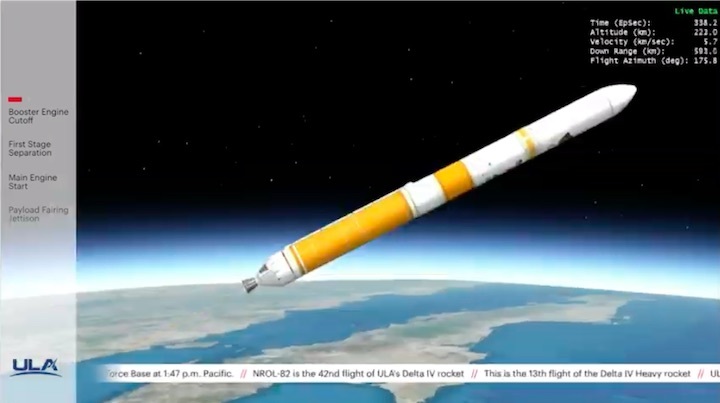
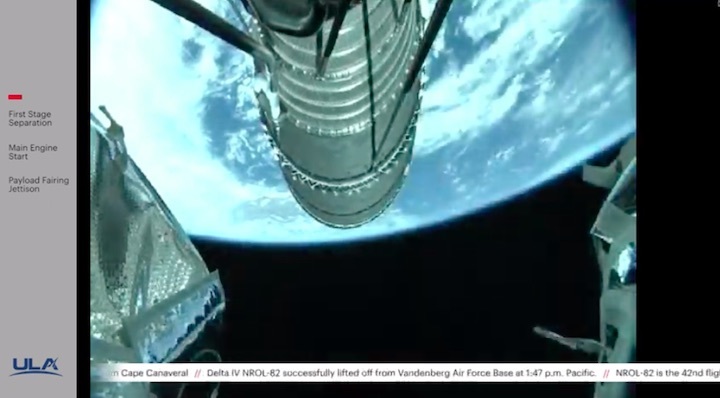
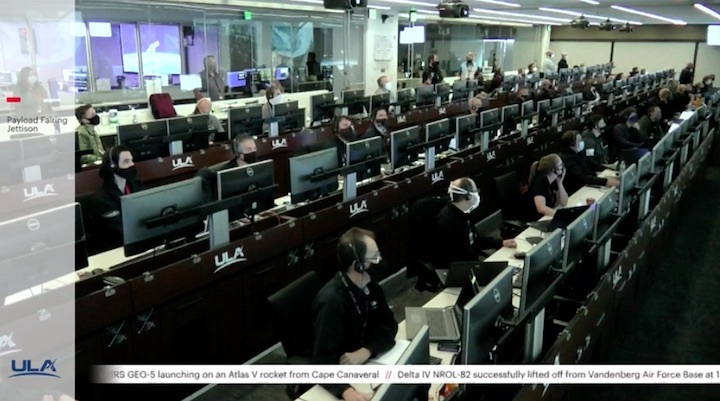
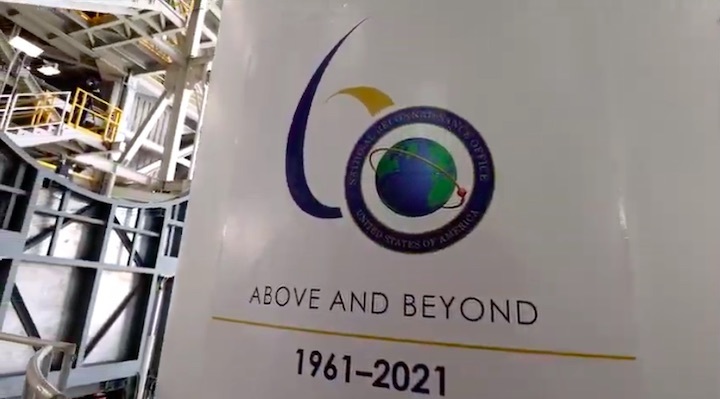
Quelle: ULA
+++
